
THE UNION OF DZOGCHEN AND BODHICHITTA
The Union of
Dzogchen and Bodhichitta
by Anyen RinpocheTranslated by Allison Graboski






Table of Contents
PART I: The Outer Teachings: A Holistic Reading
Chapter 1 19
Chapter 2 35
Chapter 3 57
PART 11: The Inner Teachings: A Holistic Reading
Chapter 4 71
Chapter 5 91
Chapter 6 107
Chapter 7 125
PART III: The Secret Teachings: A Holistic Reading
Chapter 8 155
Chapter 9 173
Chapter 10 203
Chapter 11 215
PART I V: Four Great Wasters and the Union
Chapter 12 229
Afterword:

Tcara hharmakirti Rinpoche

`Dedication
For my Root Lama:You ripened into the great Dharmakaya, Went to the primordial state where all phenomena are exhausted, In which all thoughts and duality dissolve like a drawing on water. I bow at the feet of Tsara Dharmakirti Rinpoche.

ctAcknowledgments
 .wiSH TO CONVEY my inexpressible gratitude to my supreme .Spiritual Guide, Khenchen Tsara Dharmakirti Rinpoche, along with all the many precious Lamas I have ever had the good fortune to study with, especially Lama Chupur, Dorlo Rinpoche, and Dehor Geshe, whose compassionate guidance, limitless kindness, and sublime wisdom perpetually inspire me.
.wiSH TO CONVEY my inexpressible gratitude to my supreme .Spiritual Guide, Khenchen Tsara Dharmakirti Rinpoche, along with all the many precious Lamas I have ever had the good fortune to study with, especially Lama Chupur, Dorlo Rinpoche, and Dehor Geshe, whose compassionate guidance, limitless kindness, and sublime wisdom perpetually inspire me.
I also extend my heartfelt thanks to everyone who made the publishing of this text possible; to my exquisite translator, Allison Graboski, without whom this text could not have been written; to my student Lorna Simons, who gave many hours of her time to reading the first several drafts; to Sidney Piburn and Steven Rhodes at Snow Lion Publications, who believed in The Union from the beginning, and to Maria Montenegro, a shining star among editors.

Introduction
 HE TIBETAN BUDDHIST perception of time has always been greatly divergent from that of the West. Tibetan Buddhists view time as a cycle called a "kalpa," or "eon," in which the Buddhist Teachings, as well as people's good qualities and their ability to put the Teachings into practice, are impermanent. The modern era is viewed as the end of a cycle of Teachings, or a "degenerate" time as it is translated from Tibetan. Traditionally, this is thought to mean that the purity of the Teachings, as well as people's ability to put them into practice, is at risk of declining. In order to safeguard the purity of the Teachings for as long as possible, many realized yogis and emanations of Buddhas and Bodhisattyas who lived in India and Tibet made prophecies about what this period would be like.
HE TIBETAN BUDDHIST perception of time has always been greatly divergent from that of the West. Tibetan Buddhists view time as a cycle called a "kalpa," or "eon," in which the Buddhist Teachings, as well as people's good qualities and their ability to put the Teachings into practice, are impermanent. The modern era is viewed as the end of a cycle of Teachings, or a "degenerate" time as it is translated from Tibetan. Traditionally, this is thought to mean that the purity of the Teachings, as well as people's ability to put them into practice, is at risk of declining. In order to safeguard the purity of the Teachings for as long as possible, many realized yogis and emanations of Buddhas and Bodhisattyas who lived in India and Tibet made prophecies about what this period would be like.
To establish the groundwork for a discussion of the Union of Dzogchen and Bodhichitta, I would first like to discuss three of the prophecies that were made about the modern era. The first prophecy said that during the degenerate age the Teachings of Dzogchen (a method for realizing the nature of mind) would be known to many, while the practice of generating Bodhichitta (the determination to gain ultimate realization for oneself for the sake of benefiting all sentient beings) would be known by only a few In Tibet, the practices of taking Bodhichitta as the method aspect of the path and Dzogchen as the wisdom aspect of the path have always been practiced as indivisible components of one path. If we examine the history of Vajrayana Buddhism, we will find that this has been consistently the case throughout the ages. Even the great yogis responsible for maintaining the Teachings in India and Tibet, such as Garab Dorje, Shri Simha, and Padmasambhava, meditated on the Outer, Inner, and Secret Teachings in union. It is often said by Tibetans that to practice the Secret Teach ings divorced from the Outer and Inner Teachings would be like trying to build a house on a block of ice.
This brings us to the second prophecy. Both Buddha Shakvamuni and Padmasambhava prophesied that one day the Buddhist Teachings would pervade the world and that the Teachings would even be practiced in countries that had not traditionally been Buddhist. Personally, this prophecy has always given me great hope, for it is only through spiritual awakening that we will find peace not only on a personal level, but also on a global scale. Indeed, these days there are thousands of new Buddhist practitioners throughout the world, and a vast redirecting of energy towards spirituality.
Finally, these first two prophecies intersect with yet a third. It was said that even in this degenerate time many people would be able to attain realization from the Vajrayana Teachings if they were put into practice properly. Of course, the word "properly" leaves much room for interpretation. In a time when Tibetan Buddhism can no longer rely upon its traditional context to shape the way in which the Teachings are practiced, it may seem unclear exactly how we are supposed to practice and apply the Teachings in our lives today.
In fact, many of my students have come to me with such concerns weighing on their minds. They have read about the history of Vajrayana Buddhism and examined the instructions laid out by the foundational texts, but they often tell me that they feel unsure about or even discouraged by them. They cannot spend their lives in retreat like the great yogis of the past. And they do not understand how to bring the nonmaterialistic Teachings of the Dharma into their lives, whose circumstances are necessarily conditioned by the modern culture of materialism and the established "system." I try to assure students that there is no need to worry; there are innumerable ways to put the wisdom of the Buddhist Teachings into practice in their everyday lives. But one thing is for certain: there is great confusion about how to merge contemporary Western life with the Dharma.
THE UNION OF DZOGCHEN AND BODHICHITTA
The approach I take to Dharma practice is very simple, yet this approach should not be taken to undermine the profundity of the Buddhadharma. This approach is based on the instructions I received from my own root Lama, Khenchen Tsara Dharmakirti Rinpoche, the experiences I have had in my life, and many long years of study and solitary retreat. It is my conclusion that the style of Dharma practice that the great yogis and practitioners of India and Tibet have relied upon up until now has been holistic in nature, and I believe that this approach is still the best one to take today. Logically speaking, the Outer, Inner, and Secret Teachings are fundamentally interconnected and should be adopted and practiced as one path. In fact, they are so fundamentally interconnected that it is actually difficult to give Teachings on one without including the others. This interconnection-along with the "Union" which is the perfect, uncontrived view and the "Union" which is the nature of mind itself-is what I like to can the Union of Dzogchen and Bodhichitta.
Next page


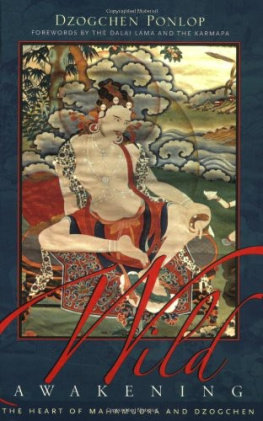
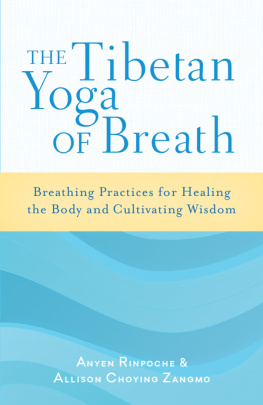



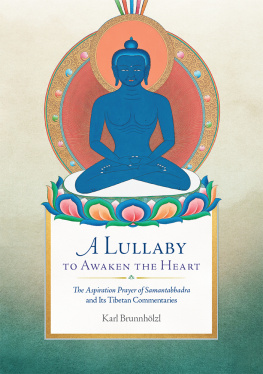
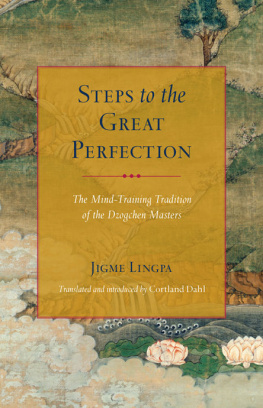
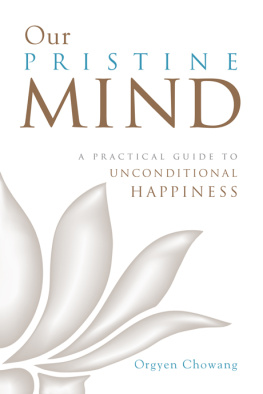










 .wiSH TO CONVEY my inexpressible gratitude to my supreme .Spiritual Guide, Khenchen Tsara Dharmakirti Rinpoche, along with all the many precious Lamas I have ever had the good fortune to study with, especially Lama Chupur, Dorlo Rinpoche, and Dehor Geshe, whose compassionate guidance, limitless kindness, and sublime wisdom perpetually inspire me.
.wiSH TO CONVEY my inexpressible gratitude to my supreme .Spiritual Guide, Khenchen Tsara Dharmakirti Rinpoche, along with all the many precious Lamas I have ever had the good fortune to study with, especially Lama Chupur, Dorlo Rinpoche, and Dehor Geshe, whose compassionate guidance, limitless kindness, and sublime wisdom perpetually inspire me.
 HE TIBETAN BUDDHIST perception of time has always been greatly divergent from that of the West. Tibetan Buddhists view time as a cycle called a "kalpa," or "eon," in which the Buddhist Teachings, as well as people's good qualities and their ability to put the Teachings into practice, are impermanent. The modern era is viewed as the end of a cycle of Teachings, or a "degenerate" time as it is translated from Tibetan. Traditionally, this is thought to mean that the purity of the Teachings, as well as people's ability to put them into practice, is at risk of declining. In order to safeguard the purity of the Teachings for as long as possible, many realized yogis and emanations of Buddhas and Bodhisattyas who lived in India and Tibet made prophecies about what this period would be like.
HE TIBETAN BUDDHIST perception of time has always been greatly divergent from that of the West. Tibetan Buddhists view time as a cycle called a "kalpa," or "eon," in which the Buddhist Teachings, as well as people's good qualities and their ability to put the Teachings into practice, are impermanent. The modern era is viewed as the end of a cycle of Teachings, or a "degenerate" time as it is translated from Tibetan. Traditionally, this is thought to mean that the purity of the Teachings, as well as people's ability to put them into practice, is at risk of declining. In order to safeguard the purity of the Teachings for as long as possible, many realized yogis and emanations of Buddhas and Bodhisattyas who lived in India and Tibet made prophecies about what this period would be like.